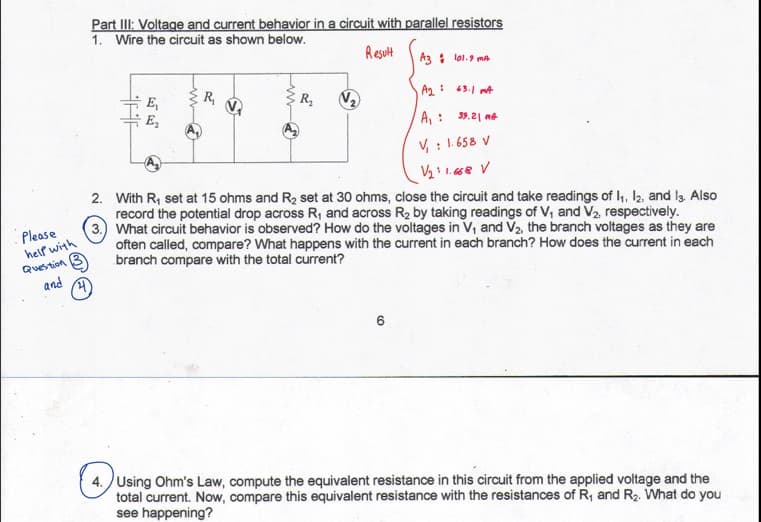With R, set at 15 ohms and R2 set at 30 ohms, close the circuit and take readings of I,, 2, and la. Also record the potential drop across R, and across R2 by taking readings of V, and V2, respectively. What circuit behavior is observed? How do the voltages in V, and V2, the branch voltages as they are often called, compare? What happens with the current in each branch? How does the current in each branch compare with the total current? 6. Using Ohm's Law, compute the equivalent resistance in this circuit from the applied voltage and the total current. Now, compare this equivalent resistance with the resistances of R, and R2. What do you see happening?
With R, set at 15 ohms and R2 set at 30 ohms, close the circuit and take readings of I,, 2, and la. Also record the potential drop across R, and across R2 by taking readings of V, and V2, respectively. What circuit behavior is observed? How do the voltages in V, and V2, the branch voltages as they are often called, compare? What happens with the current in each branch? How does the current in each branch compare with the total current? 6. Using Ohm's Law, compute the equivalent resistance in this circuit from the applied voltage and the total current. Now, compare this equivalent resistance with the resistances of R, and R2. What do you see happening?
Introductory Circuit Analysis (13th Edition)
13th Edition
ISBN:9780133923605
Author:Robert L. Boylestad
Publisher:Robert L. Boylestad
Chapter1: Introduction
Section: Chapter Questions
Problem 1P: Visit your local library (at school or home) and describe the extent to which it provides literature...
Related questions
Concept explainers
KVL and KCL
KVL stands for Kirchhoff voltage law. KVL states that the total voltage drops around the loop in any closed electric circuit is equal to the sum of total voltage drop in the same closed loop.
Sign Convention
Science and technology incorporate some ideas and techniques of their own to understand a system skilfully and easily. These techniques are called conventions. For example: Sign conventions of mirrors are used to understand the phenomenon of reflection and refraction in an easier way.
Question

Transcribed Image Text:Part II: Voltage and current behavior in a circuit with parallel resistors
1. Wire the circuit as shown below.
Result
A3 : lol.9 ma
R,
Ag: 43.1 mt
E,
E,
R,
A, : 39.2| me
V : 1. 658 V
2. With R, set at 15 ohms and R2 set at 30 ohms, close the circuit and take readings of l,, I2, and Ia. Also
record the potential drop across R, and across R2 by taking readings of V, and V2, respectively.
(3.) What circuit behavior is observed? How do the voltages in V, and V2, the branch voltages as they are
often called, compare? What happens with the current in each branch? How does the current in each
branch compare with the total current?
Please
helf with
Question
and
6
4. JUsing Ohm's Law, compute the equivalent resistance in this circuit from the applied voltage and the
total current. Now, compare this equivalent resistance with the resistances of R, and R2. What do you
see happening?
Expert Solution
This question has been solved!
Explore an expertly crafted, step-by-step solution for a thorough understanding of key concepts.
This is a popular solution!
Trending now
This is a popular solution!
Step by step
Solved in 3 steps

Knowledge Booster
Learn more about
Need a deep-dive on the concept behind this application? Look no further. Learn more about this topic, electrical-engineering and related others by exploring similar questions and additional content below.Recommended textbooks for you

Introductory Circuit Analysis (13th Edition)
Electrical Engineering
ISBN:
9780133923605
Author:
Robert L. Boylestad
Publisher:
PEARSON

Delmar's Standard Textbook Of Electricity
Electrical Engineering
ISBN:
9781337900348
Author:
Stephen L. Herman
Publisher:
Cengage Learning

Programmable Logic Controllers
Electrical Engineering
ISBN:
9780073373843
Author:
Frank D. Petruzella
Publisher:
McGraw-Hill Education

Introductory Circuit Analysis (13th Edition)
Electrical Engineering
ISBN:
9780133923605
Author:
Robert L. Boylestad
Publisher:
PEARSON

Delmar's Standard Textbook Of Electricity
Electrical Engineering
ISBN:
9781337900348
Author:
Stephen L. Herman
Publisher:
Cengage Learning

Programmable Logic Controllers
Electrical Engineering
ISBN:
9780073373843
Author:
Frank D. Petruzella
Publisher:
McGraw-Hill Education

Fundamentals of Electric Circuits
Electrical Engineering
ISBN:
9780078028229
Author:
Charles K Alexander, Matthew Sadiku
Publisher:
McGraw-Hill Education

Electric Circuits. (11th Edition)
Electrical Engineering
ISBN:
9780134746968
Author:
James W. Nilsson, Susan Riedel
Publisher:
PEARSON

Engineering Electromagnetics
Electrical Engineering
ISBN:
9780078028151
Author:
Hayt, William H. (william Hart), Jr, BUCK, John A.
Publisher:
Mcgraw-hill Education,